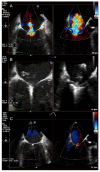Acute Ischaemic Mitral Valve Regurgitation
- PMID: 36233410
- PMCID: PMC9571705
- DOI: 10.3390/jcm11195526
Acute Ischaemic Mitral Valve Regurgitation
Abstract
Acute ischaemic mitral regurgitation (IMR) is an increasingly rare and challenging complication following acute myocardial infarction. Despite recent technical advances in both surgical and percutaneous interventions, a poor prognosis is often associated with this challenging patient cohort. In this review, we revisit the diagnosis and typical echocardiographic features, and evaluate current surgical and percutaneous treatment options for patients with acute IMR.
Keywords: acute mitral regurgitation; acute myocardial infarction; percutaneous edge-to edge repair.
Conflict of interest statement
The authors declare no conflict of interest.
Figures



Similar articles
-
Echocardiographic Assessment of Ischaemic Mitral Regurgitation, Mechanism, Severity, Impact on Treatment Strategy and Long Term Outcome.Acta Inform Med. 2016 Jun;24(3):172-7. doi: 10.5455/aim.2016.24.172-177. Epub 2016 Jun 4. Acta Inform Med. 2016. PMID: 27482130 Free PMC article.
-
Operative Results of Mitral Valve Repair and Replacement in Chronic Ischaemic Mitral Valve Regurgitation.Heart Lung Circ. 2020 Nov;29(11):1713-1724. doi: 10.1016/j.hlc.2020.03.007. Epub 2020 Apr 9. Heart Lung Circ. 2020. PMID: 32493579
-
Conservative, surgical, and percutaneous treatment for mitral regurgitation shortly after acute myocardial infarction.Eur Heart J. 2022 Feb 12;43(7):641-650. doi: 10.1093/eurheartj/ehab496. Eur Heart J. 2022. PMID: 34463727
-
[Surgical treatment of ischemic mitral regurgitation].Nihon Geka Gakkai Zasshi. 2006 Jan;107(1):21-6. Nihon Geka Gakkai Zasshi. 2006. PMID: 16482892 Review. Japanese.
-
Chronic ischemic mitral valve regurgitation and surgical perspectives.World J Cardiol. 2018 Oct 26;10(10):141-144. doi: 10.4330/wjc.v10.i10.141. World J Cardiol. 2018. PMID: 30386491 Free PMC article. Review.
Cited by
-
Left Ventricular Papillary Muscle: Anatomy, Pathophysiology, and Multimodal Evaluation.Diagnostics (Basel). 2024 Jun 16;14(12):1270. doi: 10.3390/diagnostics14121270. Diagnostics (Basel). 2024. PMID: 38928685 Free PMC article. Review.
-
Comprehensive Analysis of Cardiovascular Diseases: Symptoms, Diagnosis, and AI Innovations.Bioengineering (Basel). 2024 Dec 7;11(12):1239. doi: 10.3390/bioengineering11121239. Bioengineering (Basel). 2024. PMID: 39768057 Free PMC article. Review.
-
Importance of reassessment to identify trajectories of chronic transition of clinical indicators in post-myocardial infarction management.Cardiovasc Interv Ther. 2024 Jul;39(3):234-240. doi: 10.1007/s12928-024-01000-w. Epub 2024 Apr 14. Cardiovasc Interv Ther. 2024. PMID: 38615302 Review.
References
-
- Vahanian A., Beyersdorf F., Praz F., Milojevic M., Baldus S., Bauersachs J., Capodanno D., Conradi L., De Bonis M., De Paulis R., et al. 2021 ESC/EACTS Guidelines for the Management of Valvular Heart Disease: Developed by the Task Force for the Management of Valvular Heart Disease of the European Society of Cardiology (ESC) and the European Association for Cardio-Thoracic Surgery (EACTS) Eur. Heart J. 2022;43:561–632. doi: 10.1093/eurheartj/ehab395. - DOI - PubMed
-
- Nishino S., Watanabe N., Kimura T., Enriquez-Sarano M., Nakama T., Furugen M., Koiwaya H., Ashikaga K., Kuriyama N., Shibata Y. The Course of Ischemic Mitral Regurgitation in Acute Myocardial Infarction After Primary Percutaneous Coronary Intervention: From Emergency Room to Long-Term Follow-Up. Circ. Cardiovasc. Imaging. 2016;9:e004841. doi: 10.1161/CIRCIMAGING.116.004841. - DOI - PubMed
Publication types
LinkOut - more resources
Full Text Sources

